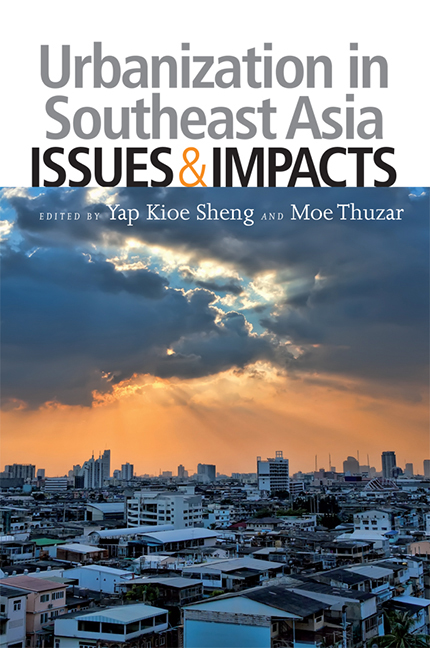Book contents
- Frontmatter
- Contents
- Message from Head, ASEAN Studies Centre
- Message from Director, Centre for Liveable Cities
- About the Contributors
- Introduction
- Urbanization in Southeast Asian Countries: Recommendations
- 1 The Challenges of Promoting Productive, Inclusive and Sustainable Urbanization
- Cities as Engines of Development
- 2 ASEAN Transport Policy, Infrastructure Development and Trade Facilitation
- 3 Competitive Cities and Urban Economic Development in Southeast Asia
- 4 Public-Private Partnerships and Urban Infrastructure Development in Southeast Asia
- 5 Regional Cooperation and the Changing Urban Landscape of Southeast Asia
- Inclusive Cities
- Cities and the Environment
- Governance, Decentralization, and Urbanization
- Urbanization from an ASEAN Perspective
- Index
5 - Regional Cooperation and the Changing Urban Landscape of Southeast Asia
from Cities as Engines of Development
Published online by Cambridge University Press: 21 October 2015
- Frontmatter
- Contents
- Message from Head, ASEAN Studies Centre
- Message from Director, Centre for Liveable Cities
- About the Contributors
- Introduction
- Urbanization in Southeast Asian Countries: Recommendations
- 1 The Challenges of Promoting Productive, Inclusive and Sustainable Urbanization
- Cities as Engines of Development
- 2 ASEAN Transport Policy, Infrastructure Development and Trade Facilitation
- 3 Competitive Cities and Urban Economic Development in Southeast Asia
- 4 Public-Private Partnerships and Urban Infrastructure Development in Southeast Asia
- 5 Regional Cooperation and the Changing Urban Landscape of Southeast Asia
- Inclusive Cities
- Cities and the Environment
- Governance, Decentralization, and Urbanization
- Urbanization from an ASEAN Perspective
- Index
Summary
This chapter discusses how urban development in Southeast Asia has and is being shaped and affected by regional cooperation. The initial reaction of some may be bewilderment or a retort that regional cooperation in Southeast Asia has always been limited, and its impact on urban development is even more so. The chapter argues against both these perspectives and, in the first part, discusses how regional cooperation in the colonial era had profound and long-lasting impacts on the urban sector. The second part of the chapter argues that trade-facilitation-focused regional cooperation is today changing the urban landscape of Southeast Asia through the reduction of transaction costs, risks, and uncertainty. The chapter notes that while primate cities will still continue to grow, there will be significant activity among the secondary cities and smaller towns of the region. The final part discusses the motive forces that will take the emerging urban landscape further, as well as the challenges faced. Policy-induced regional cooperation will change urban patterns, but further development depends on economic growth and the ability to take advantage of market forces. While all of Southeast Asia is considered, the focus is on mainland Southeast Asia, which includes Thailand as well as the newer members of ASEAN — Cambodia, Laos, Myanmar, and Vietnam — which are primarily thought of in terms of their ability to “catch up” with older members. The chapter argues that their reputation as laggards may become inappropriate in a very short time.
Colonial ERA Regional Cooperation
The evolution of Southeast Asian urbanization has been depicted by Dutt and others as consisting of four phases: (i) indigenous urbanization, (ii) colonial urbanization, (iii) extended pre-industrial urbanization, and (iv) industrial city urbanization (Dutt 1994). The focus of many studies has been on colonial urbanization and, in particular, the location of major cities in coastal areas or at river mouths to support trading activities and, later, to facilitate the export of raw materials from the colonized countries. Urban development, therefore, took place within the context of a global economy which was effectively controlled by a few European countries and prominent business concerns within these countries.
- Type
- Chapter
- Information
- Urbanization in Southeast AsiaIssues and Impacts, pp. 154 - 172Publisher: ISEAS–Yusof Ishak InstitutePrint publication year: 2012



